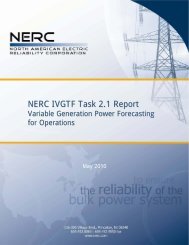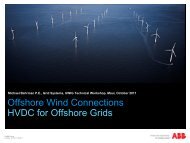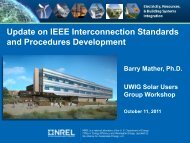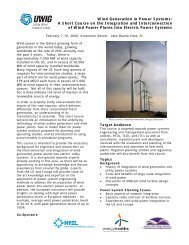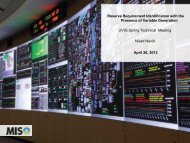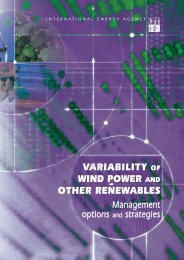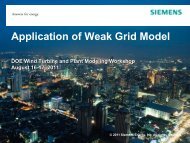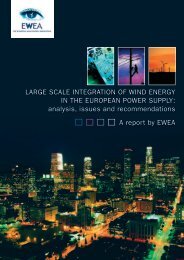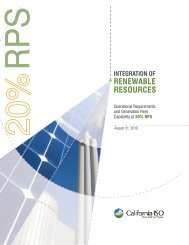MISO Energy Storage Study Phase 1 Report - Utility Wind ...
MISO Energy Storage Study Phase 1 Report - Utility Wind ...
MISO Energy Storage Study Phase 1 Report - Utility Wind ...
Create successful ePaper yourself
Turn your PDF publications into a flip-book with our unique Google optimized e-Paper software.
EXECUTIVE SUMMARY<br />
Introduction<br />
<strong>MISO</strong> is a non-profit member based organization regulated by the federal energy regulatory<br />
commission (FERC). As a Regional Transmission Organization (RTO), <strong>MISO</strong> provides<br />
electricity consumers in 13 states with regional grid management and open access to<br />
transmission facilities through a tariff closely regulated by FERC.<br />
State legislated renewable portfolio standards (RPS) within the <strong>MISO</strong> footprint in Montana,<br />
Minnesota, Wisconsin, Iowa, Missouri, Illinois, Michigan, Ohio, and Pennsylvania require<br />
varying percentages of electrical energy be met from renewable energy resources starting in<br />
2010. These mandates resulted in initiatives to integrate renewable energy generation, primarily<br />
from wind, into the <strong>MISO</strong> market. <strong>Wind</strong> resources now account for 6 percent of installed<br />
capacity (approximately 9.2 GW) and 3.5 percent of generation, producing hourly capacity up to<br />
6.7 GW 1 . Economic electricity generation from wind typically occurs some distance from load<br />
centers, requiring new transmission be constructed to reach consumers. Typical wind patterns<br />
produce higher energy at times when electricity demand is low. <strong>Wind</strong> generation is also variable<br />
and has to be carefully balanced with conventional resources in order to maintain system<br />
reliability.<br />
As significant variable generation resources are added to the transmission grid the system<br />
complexities associated with balancing generation and demand increase. Greater flexibility is<br />
required to maintain reliable service. In this circumstance, the role that energy storage plays in<br />
systems planning becomes important. Long-term energy storage is attractive because it can be<br />
used to shift electricity generated during low demand periods for use during peak demand. Shortterm<br />
energy storage also has potential value in providing a frequency regulating resource to<br />
maintain system stability. <strong>MISO</strong> currently accommodates long-term storage resources in its<br />
markets in the form of pumped hydro storage (PHS). Short-term storage is accommodated as a<br />
regulating reserve resource in the <strong>MISO</strong> ancillary services market (ASM).<br />
To better understand the role of energy storage, the <strong>Energy</strong> <strong>Storage</strong> <strong>Study</strong> was initiated by <strong>MISO</strong><br />
to model several hypotheses around battery, compressed air, and pumped hydro energy storage<br />
technologies. The study explores reliability, market, and planning benefits that storage<br />
technologies could potentially provide. The study seeks to determine economic potential for<br />
storage technologies in <strong>MISO</strong>. It will estimate the price inflection point at which energy storage<br />
may become economically feasible. Finally, the study will suggest potential <strong>MISO</strong> energy and<br />
operating reserve markets enhancement products.<br />
1 2010 <strong>MISO</strong> State of the Markets Market Monitor <strong>Report</strong> June 2011, Potomac Economics<br />
v




